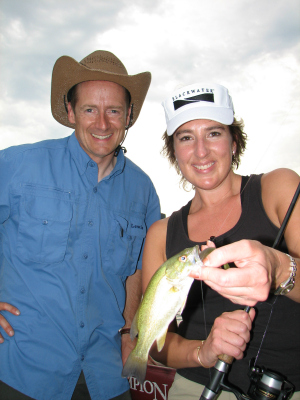‘Daddy’s fish’ inspires granddaughter’s bass fever
By Gary Lewis
 22 pounds, 4 ounces. A largemouth bass only gets that big when there is an alignment of factors, a convergence of genetics, water level, food supply, temperature and fishing pressure. And it requires a fisherman with the skill, the time and the luck to be at the right place at the right time.
22 pounds, 4 ounces. A largemouth bass only gets that big when there is an alignment of factors, a convergence of genetics, water level, food supply, temperature and fishing pressure. And it requires a fisherman with the skill, the time and the luck to be at the right place at the right time.On June 2, 1932, the day after the stock market hit its bottom, three years into the Great Depression, a 20-year-old Georgia farm boy named George Washington Perry unlimbered his bait-casting rod and tied on a lure called a Creek Chub Wiggle Fish.
He and a buddy drove a 1930 Model A Ford down to the lake, straining to see the road through the rain.
They had one lure. George hooked a chain pickerel. It broke the line. The fish threw the lure, which floated to the top. They paddled their homemade boat over and retied it, then traded off with the rod. George’s turn again. When he hooked the fish, he was more concerned with keeping the lure than how big the fish was.
It was the biggest bass either man had ever seen. They took the fish to a nearby store, where the quick-thinking proprietor pointed them across the street to the Post Office and a government-certified scale. 22 pounds, 4 ounces.
It was the biggest bass ever caught and it became the standard by which all largemouth bass are measured. Perry took his fish home. It fed the family for four days.
That fish inspired generations of big fish hunters. Montgomery Lake turned out a few more big ones, but the convergence had passed. George Washington Perry’s name passed into legend.
One day last year, I got an email from a reader who knew the story and Perry’s granddaughter, Alison. He gave me her phone number, I called her.
 Alison Perry, the thirty-something granddaughter of the most famous bass fisherman in the world had moved to Bend, Oregon. “I wanted to spend more time outdoors.”
Alison Perry, the thirty-something granddaughter of the most famous bass fisherman in the world had moved to Bend, Oregon. “I wanted to spend more time outdoors.” And she wanted to catch fish. Like ‘Daddy’s Fish.’
The granddaughter, as I began to think of her, had never, ever, caught a bass. “I hear about people trying to beat my grandfather’s record. Someday, somebody is going to catch a bigger bass and I want it to be me. I want to keep it in the family.”
Last month, on a lake in Japan, an angler named Manabu Kurita tied into a big bass that has a shot at that coveted top spot in the records. And the scale told the tale. 22 pounds, 5 ounces.
What we know is that it was caught, using live bait, on Toray Line in Japan’s Lake Biwa. And we also know that to beat the record, the contender has to weigh at least two ounces more than the previous record. At best, Kurita’s fish and Daddy’s fish will share the top spot in the record books.
Suddenly, Alison’s quest was urgent. Not only to keep it in the family, but to keep it for America, for after 77 years, Daddy’s fish is part of our American heritage.
I called David Swendseid who knows something about setting records. He once held the Oregon state record for smallmouth bass.
Reading the account of George Perry’s fish had inspired him as a young man and the pursuit had made him a very talented angler.
It was time to return the favor. We hit Lake Billy Chinook on an August evening. We found the smallmouth in a cove and tempted them with lightweight jig heads and plastics.
David taught Alison how to cast. Her line twitched. I had her swing her line over to me and showed her what a bite feels like. Then I had her practice setting the hook against that tug. Thus armed, she set the hook and boated her first bass.
The next week, we turned our attention to largemouth. That was when Damien Nurre of Deep Canyon Outfitters heard about the quest. He invited us out to fish Buckhorn, a 15-acre lake managed for largemouth.
Joining us, were Ross Walton, David’s wife Bryn and my daughter Mikayla. Buckhorn is fly-fishing only, but we received a special spinning rod dispensation for Alison.
We put Damien, David, Bryn and Alison in one boat. Ross, Mikayla and I took the other boat, casting big poppers. David rigged Alison’s rod with a 4.8 inch Jackal FlickShake worm that she fired to the drowned trees and the shoreline.
In shallow water, on the edge of the trees, a one-pound largemouth inhaled her bait. It ran, it jumped, it thrashed, but the Perry magic was strong. She landed the one-pound largemouth and seven more like it – each one a 1/22nd scale version of Daddy’s Fish.
“Catching my first largemouth bass was both a historical and emotional moment. I felt an unexpected kinship to that fish, like he had been a part of my family for a long, long time,” Alison told me later.
The thing I like about fishing is that a 20-year-old farm boy can set a record that bridges a gap between nations, and 77 years later, connects with his granddaughter. And anyone could be the next to catch a record fish – a thirty-something granddaughter, a bass pro, a weekend angler or another 20-year-old farm boy.


